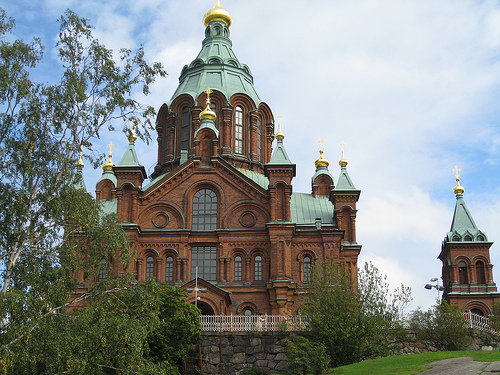

Location: Kanavakatu 1, Helsinki
Tel. 09- 634 267
Trolley:
2, 4
Open: May- Sept daily; Oct- Apr Tue- Sun
Uspenski Cathedral or Cathedral of the Dormition of the Theotokos
(Swedish: Uspenskijkatedralen) is the main church or cathedral of the
Helsinki Orthodox Church and at the same time of the Diocese of Helsinki
and the Orthodox Archdiocese of Finland. The red brick church is located
in the center of Helsinki on the Katajanokka rock. Uspenski Cathedral is
the largest Orthodox church in Northern and Western Europe. It is also a
popular tourist destination with up to half a million visitors every
year.
The name of the church comes from the Slavic word uspenie,
which means falling asleep (death). Indeed, the cathedral is dedicated
to the memory of the God-Birther's deathly sleep, whose memorial day is
celebrated on August 15.
The cathedral was designed by the famous Russian church architect,
academician Aleksei M. Gornostayev. The church's architecture is
strongly influenced by the 16th-century Russian stone church located
near Moscow in Kolomenskoye. Uspenski Cathedral was built between 1862
and 1868 mainly with donation funds and inaugurated on October 25, 1868.
The Uspenski Cathedral was built using bricks brought from Åland from
the Bomarsund fortress that was being demolished. In the 1960s, the
cathedral was renovated and its domes were gilded, and the repair work
was completed in time for the church's centenary in 1968.
The
domes of the church were coated with 24 carat gold again starting in
2004, and the gilding work was completed in May 2007. The stainless
steel frames of the domes' root parts date from the 1960s. Copper sheets
new metalsmith Antero Flander Rautalammi; the crosses and the balls
below them and the copper plating of the largest dome remained in use
from the old parts. The gilding work was carried out by master goldsmith
Harri Virtanen and master goldsmith Raimo Snellman and their work teams.
The dome work with gilding as a whole cost about 500,000 euros, of which
170,000 euros were received as donations. In 2005, five domes were
renovated and installed. The rest of the domes were lifted back into
place starting on June 4, 2007.
On the north wall was placed an
icon said to work miracles, the Mother of God of Kozelščan, which was
brought to the church from Sorvali in Vyborg. The icon is decorated with
a pearl, and under its protective glass there are many jewelry and
crosses received as thanks. The icon was stolen in the early hours of
June 9, 2010. The church had been broken into and an attempt had been
made to take another icon as well. The police considered the theft to be
a commissioned work and suspected that the stolen icon ended up abroad -
mainly in Eastern Europe - because it was considered practically
impossible to sell it in Finland. However, the Mother of God of
Kozelščani was found in a field cache near Turku in February 2011, when
a man serving time for theft told about the location on his own
initiative. The icon was taken to the monastery of Uusi Valamo in
Heinävedi to be repaired.
In August 2007, the icon of St.
Nicholas the Wonderworker was taken from the church in the middle of the
day.
The park next to the cathedral was designed by Svante
Olsson. The planting of the park started in 1897. The park's name was
Katajanokanpuisto until 2014. In 2014, the park was renamed Tove Jansson
park.
Although the church externally is in accordance with the old Slavic
tradition, the interior of the church shows its Byzantine tradition. The
interior is spacious, and the ceiling is supported by four large columns
carved from a single block of granite. In the Orthodox way, there are no
pews in the church, but a few seats are placed on the edges of the hall.
In the front part of the church is the iconostasis, behind which is the
altar. The area of the church is 967 square meters. The church has
thirteen gilded onion-shaped domes, one large and twelve smaller ones.
The number of domes represents Christ and the twelve apostles. In
addition, there is another dome on top of the bell tower.
On the
ground floor of the cathedral there is a parish hall and a crypt chapel
dedicated to the priest-martyr Aleksandr Hotovitski (d. 1937). Various
events are organized in the crypt, such as exhibitions of church art and
ecclesiastical objects and lectures.